|
The Scarfe-La Trobe Collection provides a full
repository of primary source material, indispensable to researchers on
Spanish theatre, richly complementing the holdings of sueltas and
desglosadas in Spain's National Library and major collections
throughout the world. Comprising so many variant texts, this collection
gives both theatre-historians and textual critics the means to compare
different versions of the same drama and to decide why the different
texts exist: whether the playwright concerned had himself produced more
than one version; whether the original text had been altered by actors
for performance - perhaps to suit their acting capacities or their
public's preferences; or whether, perhaps, the printers, always
concerned to save money on paper etc., had made textual cuts and changes
on their own account.
The editions in this collection can provide, too,
essential clues to resolve cases of disputed or confused authorship as
well as problems of dating and uncertainties about performance and
reception. The fact that a significant number were used, or were printed
from manuscripts used by specific theatre companies, while many have
wrappers on which the printers list titles of other plays being offered
for sale, makes this collection additionally important to a thorough
knowledge of Spain's theatre-history.
For more information (with further images) about this
collection, see the April 2003 book of
the month.
[Ann L. Mackenzie]
|

title-page of Rojas La Celestina
(Bi7-l.19) |
Fernando de Rojas La Celestina (Tragicomedia de
Calisto y Melibea)
Madrid: Juan de la Cuesta, 1619
Old Library Bi7-1.19
A late edition of probably the most famous and
influential work in Spanish literature, after Don Quixote. The
first known edition appeared anonymously at Burgos in 1499. Entitled
Comedia de Calisto y Melibea it contained sixteen acts, each
preceded by an 'argumento'. Another version of the text appeared in
Toledo (1500) and Seville (1501), with the addition of a letter entitled
Del autor a un amigo, some acrostic verses, the incipit, and
three stanzas written by the corrector Alonso de Proaza. In 1502
five further edtions appeared containing five new acts, inserted in the
fourteenth act of the original. A further act was added in 1526.
The author was born at Puebla de Montalván (province
of Toledo) in 1476, and died in 1541. He became alcalde mayor at
Talavera. His Jewish parents had been forcibly converted and it has been
argued that La Celestina is a roman-ŕ-clef on the conversos
in Spain.
|
|
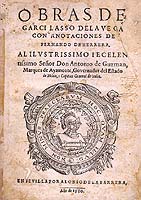
title-page of Vega Obras (Hunterian Db.3.35) |
Garcilaso de la Vega Obras . con anotaciones de
Fernando de Herrera
Seville: Alonso de la Barrera, 1580
Hunterian Db.3.35
Garcilaso de la Vega (1501-1536) was the most
representative Renaissance gentleman whom Spain produced. Born of a
noble family, he received a good education in Latin, Greek, French and
Italian. He was early attached to the Emperor's household and served him
in the most remote regions, fighting in Austria and Africa and being
entrusted with delicate diplomatic missions. He died while attacking a
fortified mill in Southern France. His literary production was slight;
there survive only three eclogues, two elegies, one epistle, five odes
and thirty-eight sonnets Herrera continued in a way the tradition
of Garcilaso and his admiration for him appears in his Anotaciones.
|
Alonso de Ercilla y Zuniga Primera, segunda, y
tercera partes de la Araucana
Madrid: en casa del Licencia do Castro, a costa de Juan de Montoya,
1597
Hunterian Db.3.30
This famous heroic poem on the fight of the Spaniards
against the natives in Chile is considered to be the Spanish Iliad
or Aeneid.
In 1554, Ercilla y Zuniga (1533-1595) joined the
Spanish expedition to Southern Chile and fought the militant Indian
tribe of the Araucans (Aucas). In the night after the battle, he wrote
down the events of the day in octave rhymes, thus creating the first
eighteen cantos which form the first part. After his return to Spain in
1562, Ercilla added two more parts, including visions and romantic
incidents, discussions on war and political matters.
The first complete edition of the Araucana
appeared in 1590. The poem was very popular: it received the praise of
Cervantes and, later, of Voltaire, and it went through numerous editions
and translations up to the nineteenth century.
|
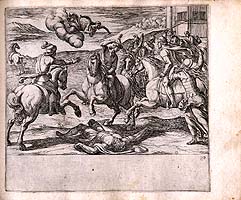
plate 8 of Van Veen Historia septem infantium de Lara (S.M.
Add. 14) |
Otto van Veen Historia septem infantium de Lara
Antwerp: Phillipp Lisaert, 1612
S.M. Add. 14
The legend of the Infantes of Lara, who lived in the
tenth century, relates how these seven brothers were betrayed by their
uncle and slain by the Moors but were afterwards avenged by their
half-brother, the Bastard Mudarra, son of the Lord of Lara and a Moorish
lady. In view of its semi-legendary nature it ranks as a romance of
chivalry, though many of the facts were recorded in the Cronica
general.
The illustrations, which are proofs before letters,
are from the collection of Sir Peter Lely.
|
Fernando de Herrara Versos
Seville: Gabriel Raaos Vejarano, 1619
Hunterian Dc.2.14
Fernando de Herrera (1534-1597), known as 'el
divino', was born in Seville and spent his life there. By about 1565 he
was the holder of a small lay benefice in the church of San Andrés and
was a member of a literary and artistic circle which met at the palace
of the Conde de Gelves, and which included many of the best-known
figures of the cultural life of the city. His fame was great in his own
day, not only as a poet but as a historian and literary arbiter. Among
his works are a Relación de la guerra de Chipre y batalla naval de
Lepanto and Tomás Moro. His best poetry was his love poetry,
whose language he drew from Petrarch; the Condesa de Gelves, Dońa Leonor
de Milán, was his inspiration. He also wrote a number of heroic and
patriotic odes, of which one of the best known is the Canción on
the battle of Lepanto.
Herrera's poems were published at Seville in 1532
with the title Algunas obras. This enlarged and 'corrected'
edition of 1619 was brought out by Francisco Pacheco, but the
authenticity of the changes he made is disputed. This copy is from the
famous library of Jean Baptiste Colbert (1619-1633), chief Minister of
Louis XIV.
|
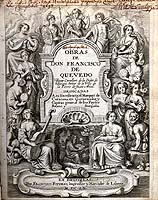
title-page of Quevedo Obras (Bn7-g.8) |
Francisco de Quevedo Obras
Brussels: Francisco Foppens, 1661
Old Library Bn7-g.8-9
Quevedo, arguably the greatest and most prolific
writer that Spain has produced, was born in Madrid in 1580 of a noble
family. He studied at Alcalá and became one of the most learned
Spaniards of his day. He took service with the Duque de Osuna in Sicily
and Naples but when Osuna fell in 1620, Quevedo was banished. He was
restored to favour on the accession of Philip IV in 1621, but eventually
incurred the enmity of the Conde Duque de Olivares and was imprisoned in
1639. He was released in 1643 but his health was broken and he died in
1645. His works can be classified as philosophical, ascetic, political,
critical, satirical, and poetical, while he also contributed one
picaresque novel, Historia de la Vida del Buscon, and several
satrical works to the literature of Spain.
|
|
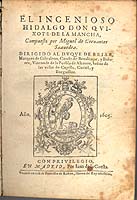
title-page of
Cervantes Don Quixote (Hunterian Dc.2.26) |
Miguel de Cervantes Saavedra El ingenioso Hidalgo
Don Quixote de la Mancha
Madrid: Juan de la Cuesta, 1605
Hunterian Dc.2.26
After ten years of struggling to make a living as an
author, Don Quixote brought Cervantes instant fame. Often cited
as the first modern novel, this celebrated work ostensibly parodies
chivalric romance while exploring the nature of storytelling and
questions of truth, history, madness, the imagination, and the relation
of life and art. Its undying humour has survived the literary fashion of
every age.
This is a copy of the first edition of Part I. The
precise printing chronology of Don Quixote has been a matter of
bibliographic confusion for some three hundred years, and remains a
subject for debate. Cervantes first obtained the privilege to print the
work on 24 September 1604 in Valladolid where he then lived; he ceded
this privilege to Francisco de Robles, the King's bookseller, who
received the work's tase, or price certificate, from the Council
of Castile in Valladolid on 20 December 1604. The first edition was
printed in Madrid by Juan de la Cuesta, the work being carried out
throughout October and November 1604: it was possibly rushed through in
time to catch the Christmas and New Year market in Castile. Certainly,
Cuesta's work was somewhat careless and there are consequently numerous
variant states of the princeps as a result of the resetting of
several gatherings during its printing. In our copy, the second quire
(often missing) is present, while signature S3 is mis-signed as P3. This
first edition is known to exist in at least one other issue which boasts
a unique variant Tasa page, although only one example of this is now
known to survive. There is speculation that there was actually an
earlier version of the work published in spring or early summer 1604,
but there is little evidence for this and Ian Michael suggests that
references to it could point to the work circulating in manuscript,
probably among university students. |
|
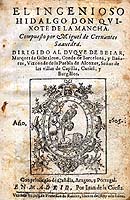
title-page of Cervantes Don
Quixote (Hunterian Dc.2.25) |
Miguel de Cervantes Saavedra El ingenioso Hidalgo
Don Quixote de la Mancha
Madrid: Juan de la Cuesta, 1605
Hunterian Dc.2.25
Such was the book's popularity that the first edition
quickly sold out. A second edition, of which this is a copy, was
produced in a print run of approximately 1750 copies, once Cervantes
obtained on 9 February 1605 a new privilege extended to cover all of the
Iberian peninsula (apart from Navarre). This edition had an additional
passage added to explain the robbery of Sancho's ass, although the
incompetent Juan de la Cuesta inserted it in the wrong place. Meanwhile,
as the book was being reset in Madrid throughout February and March
1605, the work was published in no less than three unauthorised editions
in Lisbon. Further pirated editions appeared from Valencia in 1605
(twice), from Brussels in 1608, 1611 and 1617, and from Milan in 1610.
The third authorised Madrid edition appeared in 1608. The first English
translation by Thomas Shelton, The history of the valorous and wittie
knight errant, Don Quixote of the Mancha, appeared in 1612, and the
first French translation in 1614.
Inscriptions in our copy suggest that the book was in
French hands before Hunter purchased it.
|
|
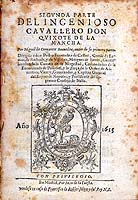
title-page of Cervantes Don Quixote, Part II (Hunterian
Dc.2.28) |
Miguel de Cervantes Saavedra Segunda parte del
ingenioso Cavallero Don Quixote de la Mancha
Madrid: Juan de la Cuesta, 1615
Hunterian Dc.2.28
This is a copy of the first edition of Part II of
Don Quixote. The second part appeared in 1615, following the
publication of a spurious sequel published under the pseudonym of Alonso
Fernández de Avellaneda in 1614. An even greater success, Cervantes
continued to explore the processes of composition in the narrative:
ironic self-referential touches include key characters in Part II having
read Part I, while Don Quixote himself leafs through the 'false' second
part of his own adventures in a visit to a printing shop.
|
|
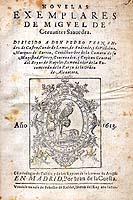
title-page of Cervantes Novelas exemplares (Hunterian
Dc.2.23) |
Miguel de Cervantes Saavedra Novelas exemplares
Madrid: Juan de la Cuesta, 1613
Hunterian Dc.2.23
This publication contains twelve short stories which
variously explore the concepts of narrative realism and idealism. Along
with Don Quixote, this is the work upon which Cervantes' literary
fame rests. Although not collected together and printed until 1613, the
stories were composed over a span of years, the earliest - El
licenciado Vidriera - dating from about 1597. 'I am the first,'
wrote Cervantes, 'to write novelas in the Castilian tongue, for the many
which here circulate in print are all translated from foreign tongues.'
|
|
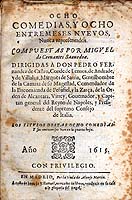
title-page of Cervantes Ocho comedias... (Hunterian Dc.2.1) |
Miguel de Cervantes Saavedra Ocho comedias, y ocho
entremeses nuevos
Madrid: Juan de Villarroel, 1615
Hunterian Dc.2.1
One of the disappointments of Cervantes' life was his
inability to win fame as a dramatist. His chief period of productivity
as a writer for the stage lies between the years 1583 and 1587 when some
twenty of his plays were performed with relative success. But with the
dramatic début of Lope de Vega, Cervantes' old fashioned methods lost
favour and he could no longer find managers who would put on his plays.
It was not until 1615 that Cervantes accepted an offer from Juan de
Villarroel to publish the eight best plays.
The Entremeses are much more successful than
the Comedias. Cervantes could create character and write
sparkling dialogue, but he was unable to sustain dramatic tension for
any length cf time, nor could he develop a plot logically. But in these
short satirical sketches where character and witty dialogue are more
important than plot he succeeds brilliantly.
|
|
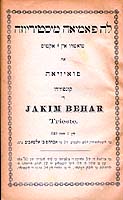
title-page of Behar La famia misteriozo (Bb8-b.8) |
Yakim Behar La famia misterioza: teatro in 4 aktos en poezia
Trieste: Avraham ben Altabev, 1 Tammuz 649 [1889]
Bourgeois Bb8-b.8
Ladino dramatic literature appeared as a new genre at
the close of the nineteenth century, largely developed around Jewish
themes, in contrast to the more enlightened complexion of general
literary activity in the language. Yakim Behar was one of a small group
of writers who distinguished themselves.
|
|